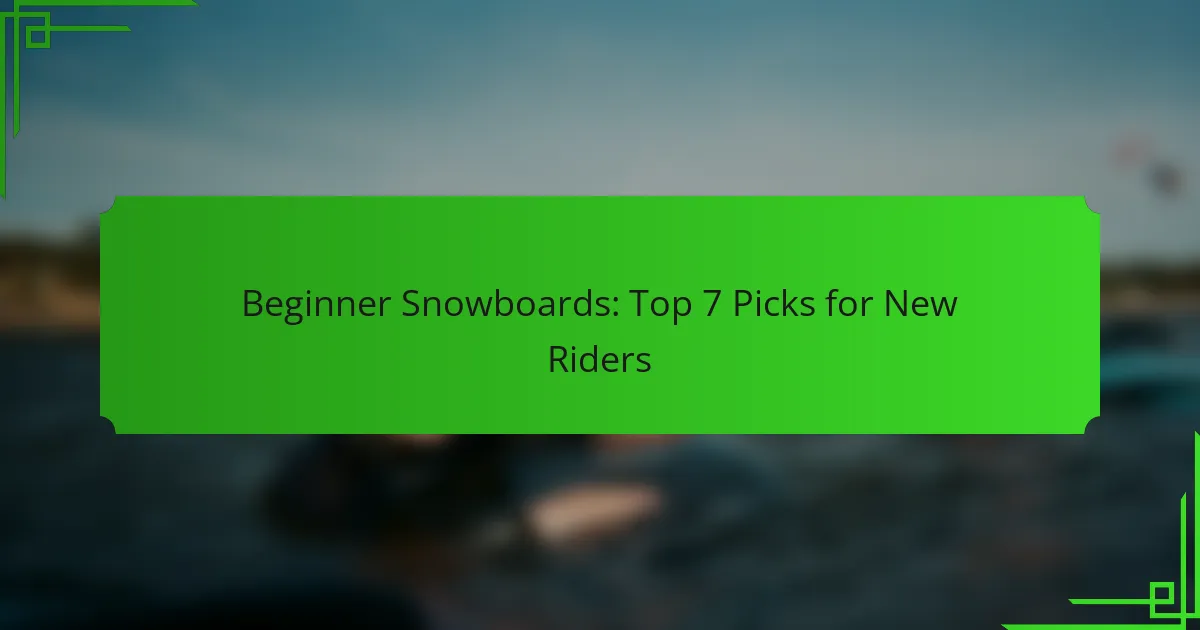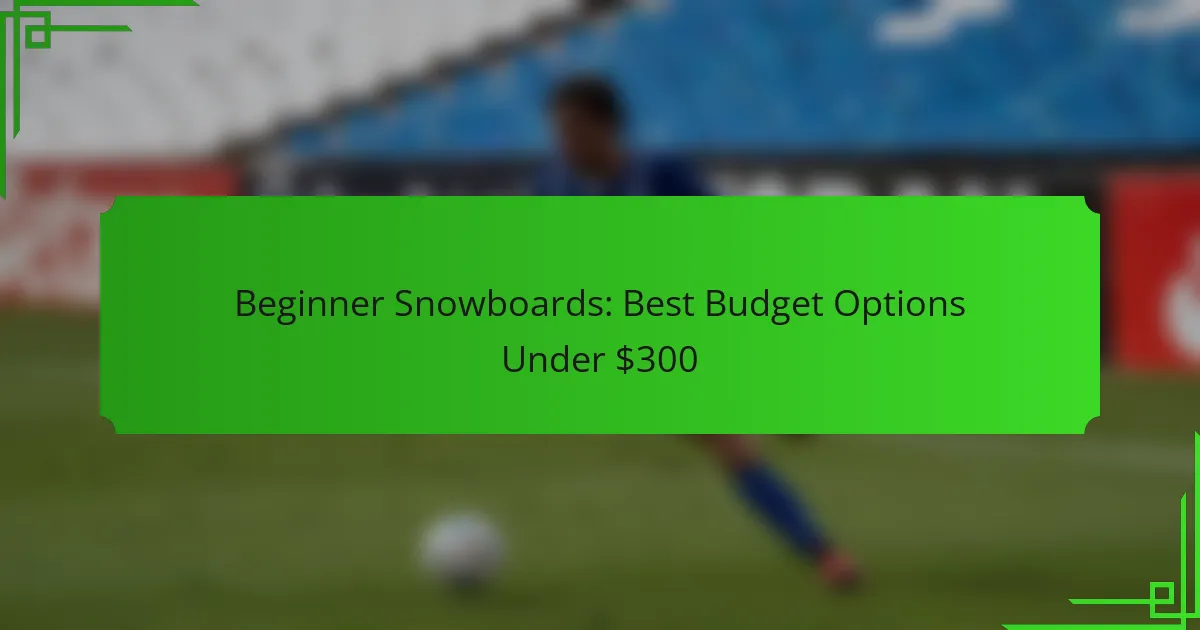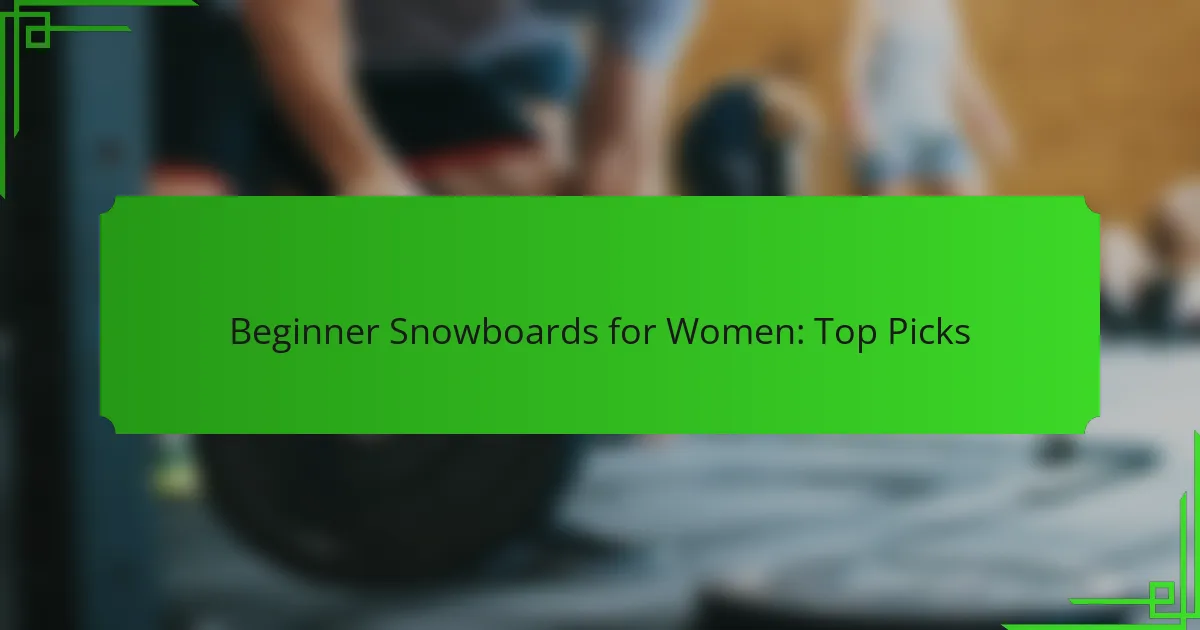What Are the Best Beginner Snowboards?
The best beginner snowboards are designed to be forgiving and easy to maneuver, helping new riders build confidence on the slopes. Key factors to consider include the board’s flex, shape, and size, which can significantly impact your learning experience.
Burton Ripcord
The Burton Ripcord is an excellent choice for beginners due to its soft flex and directional shape, which makes turning easier. Its Flat Top profile provides stability while allowing for a catch-free ride, ideal for those just starting out.
This board is available in various sizes, typically ranging from 145 cm to 160 cm, accommodating different heights and weights. It’s a versatile option that performs well in various snow conditions, making it a reliable companion for new snowboarders.
GNU Carbon Credit
The GNU Carbon Credit features a twin shape and a soft flex, making it user-friendly for beginners. Its rocker-camber profile offers a balance of stability and playfulness, allowing new riders to explore different riding styles.
This snowboard is available in sizes from 145 cm to 159 cm, catering to a wide range of riders. Its eco-friendly construction also appeals to environmentally conscious consumers, adding value to your purchase.
K2 Standard
The K2 Standard is designed specifically for beginners, featuring a soft flex and a catch-free rocker profile. This design helps new snowboarders learn to turn and stop without the fear of catching an edge.
Available in sizes from 145 cm to 157 cm, the K2 Standard is suitable for various body types. Its affordable price point makes it an attractive option for those just starting their snowboarding journey.
Salomon Pulse
The Salomon Pulse is another great beginner snowboard, known for its forgiving flex and easy-to-control shape. Its Rock Out Camber profile provides stability and allows for smooth transitions, making it easier for new riders to gain confidence.
This board typically comes in sizes ranging from 148 cm to 156 cm, accommodating different rider preferences. The Salomon Pulse is also budget-friendly, making it a smart choice for those looking to get into snowboarding without breaking the bank.
Ride Agenda
The Ride Agenda is a versatile beginner snowboard that combines a soft flex with a directional shape, making it easy to navigate various terrains. Its rocker profile helps prevent edge catches, allowing new riders to focus on learning the basics.
Available in sizes from 150 cm to 158 cm, the Ride Agenda caters to a range of heights and weights. Its durability and performance in different snow conditions make it a reliable option for those starting out in the sport.
How to Choose a Beginner Snowboard?
Choosing a beginner snowboard involves understanding your riding style, evaluating board length, and checking the flex rating. These factors will help you select a board that enhances your learning experience and builds confidence on the slopes.
Consider your riding style
Your riding style significantly influences the type of snowboard you should choose. Beginners typically fall into two categories: freestyle and all-mountain. Freestyle boards are shorter and more maneuverable, ideal for tricks and park riding, while all-mountain boards offer versatility for various terrains.
Think about where you plan to ride most often. If you want to explore groomed runs and powder, an all-mountain board is a better fit. If you’re interested in park features and jumps, look for a freestyle option.
Evaluate board length
Board length is crucial for stability and control. As a general guideline, a beginner snowboard should reach between your chin and nose when stood on its tail. This range helps maintain balance while allowing for easier turns.
Additionally, consider your weight. Heavier riders may benefit from a slightly longer board for better support, while lighter riders might prefer a shorter board for enhanced maneuverability. Always check the manufacturer’s recommendations for specific length ranges based on weight.
Check flex rating
The flex rating of a snowboard affects how it responds to your movements. Softer flex boards are more forgiving and easier to control, making them ideal for beginners. A flex rating of 3 to 5 is typically recommended for those just starting out.
As you progress, you may want to explore stiffer boards for better performance at higher speeds or on varied terrain. However, starting with a softer flex will help you build foundational skills without overwhelming you.
What Are the Key Features of Beginner Snowboards?
Beginner snowboards are designed to provide a user-friendly experience, focusing on features that enhance control, stability, and safety. Key characteristics include soft flex, directional shape, and catch-free edges, all aimed at helping new riders build confidence on the slopes.
Soft flex for easier control
A soft flex in beginner snowboards allows for greater maneuverability, making it easier for novice riders to turn and balance. This flexibility helps absorb bumps and irregularities on the snow, providing a smoother ride.
When selecting a snowboard, look for models with a flex rating typically in the low to mid-range, as these will offer the forgiving characteristics that beginners need. Avoid stiffer boards, which can be more challenging to control.
Directional shape for stability
Beginner snowboards often feature a directional shape, which means they are designed to be ridden primarily in one direction. This design enhances stability and makes it easier to maintain control while learning to carve turns.
Choosing a snowboard with a directional shape can help beginners feel more comfortable, as it naturally guides the rider forward. Look for boards that have a longer nose and a shorter tail, which can aid in stability during descents.
Catch-free edges for safety
Catch-free edges are designed to minimize the chances of the board snagging on the snow, which can lead to falls. These edges are typically rounded or beveled, allowing for smoother transitions and reducing the risk of catching an edge during turns.
When shopping for a beginner snowboard, prioritize models that advertise catch-free edges. This feature is particularly beneficial for new riders who are still mastering their balance and turning techniques, as it promotes a safer learning environment.
Where to Buy Beginner Snowboards?
Beginner snowboards can be purchased from various sources, each offering unique advantages. Local ski shops provide personalized service, while online retailers offer convenience and often better prices. Specialty stores like REI combine both, featuring knowledgeable staff and a wide selection.
Local ski shops
Local ski shops are excellent for beginners looking to buy snowboards because they offer personalized advice and the opportunity to physically inspect the boards. Staff members are usually experienced snowboarders who can recommend the best options based on your skill level and preferences.
When visiting a local shop, consider asking about package deals that include bindings and boots, which can save you money. Additionally, many shops offer seasonal discounts or rental programs that allow you to try before you buy.
Online retailers like Amazon
Online retailers like Amazon provide a vast selection of beginner snowboards at competitive prices. Shopping online allows you to compare multiple brands and models quickly, often with customer reviews to guide your decision.
However, be cautious when purchasing online. Ensure you check the return policy in case the snowboard doesn’t meet your expectations. Look for boards that come with warranties, which can provide peace of mind for your investment.
Specialty stores like REI
Specialty stores like REI offer a curated selection of beginner snowboards along with expert advice from staff who are passionate about snow sports. These stores often have knowledgeable employees who can help you find the right board based on your height, weight, and riding style.
Additionally, REI frequently hosts events and workshops that can help beginners learn more about snowboarding and gear maintenance. Consider joining their membership program for discounts and access to exclusive sales, which can make your purchase more affordable.
What Is the Price Range for Beginner Snowboards?
The price range for beginner snowboards typically falls between $300 and $600. This range offers a variety of options that balance quality and affordability, making it easier for newcomers to find a suitable board without overspending.
Entry-level boards from $300
Entry-level snowboards priced around $300 are designed specifically for beginners, focusing on stability and ease of use. These boards often feature softer flex patterns, which help new riders maintain control while learning basic techniques.
When shopping for entry-level boards, consider brands known for their beginner-friendly designs, such as Burton, K2, and Rossignol. These boards usually come with features like catch-free edges and forgiving shapes, which enhance the learning experience.
It’s essential to try out different models if possible, as personal comfort and fit can vary significantly. Look for boards that offer a good balance of performance and durability, ensuring they can withstand the wear and tear of learning without requiring frequent replacements.






